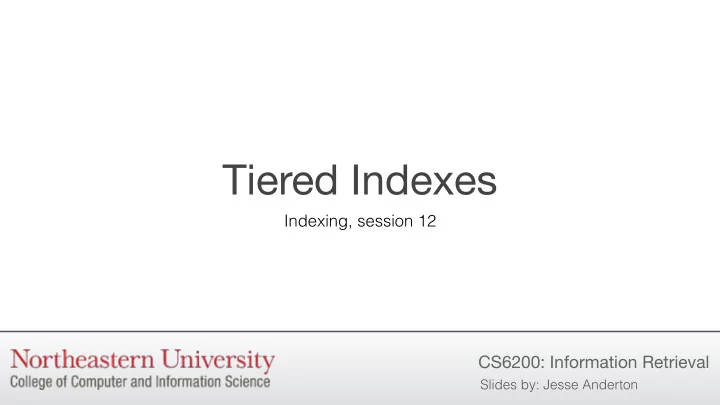

Tiered Indexes Indexing, session 12 CS6200: Information Retrieval Slides by: Jesse Anderton
Champion Lists Champion Lists Champion Lists are inverted lists for terms which contain only the highest-scoring d1 d2 d3 documents for that term. tf cheap 2 6 0 tf used 1 0 6 At indexing time, we compute a document’s matching score for a term. If it’s one of the top tf cars 8 3 5 r documents, we add it to the champion list. cheap d1 d2 champions At query time, we first match documents in the champion list for any query term, and only used d1 d3 champions proceed to other documents if that didn’t find enough results. cars d1 d3 champions We can pick larger r for terms with higher df . Why would this help? d2 others
Sorting by Quality As a generalization of champion lists, we can sort the postings for a term by some Postings sorted by quality document quality score q d . Suppose the d1 d2 d3 quality score is part of our matching function: q d 0.5 0.25 0.75 � score ( D , Q ) = λq D + ( 1 − λ ) f ( w ) · g ( w ) cheap d1 d2 w ∈ Q Recall that we want to sort the postings by a used d3 d1 common value so we can easily merge them. We previously sorted by docid. cars d3 d1 d2 Sorting by global document quality still allows efficient merging, though sorting by a term-based matching score would not.
Impact Ordering If we use term-at-a-time processing, we Postings sorted by tf can sort the lists in different orders. d1 d2 d3 Impact Ordering sorts lists by some tf cheap 2 6 0 notion of term relevance. As a simple tf used 1 0 6 example, tf w,d can be used. tf cars 8 3 5 Here, we often stop processing documents early in each list. We may cheap d2 d1 process query terms in order of decreasing df , and stop processing each used d3 d1 list when document scores stop changing much. We may also skip low- df cars d1 d3 d2 terms.
Tiered Indexes Tiered Indexes take these ideas further. d1 d2 d3 We use multiple indexes. Documents tf cheap 27 3 0 likely to have the highest scores are in tf used 17 0 6 the first index, and subsequent indexes tf cars 8 13 16 have progressively worse documents. cheap d1 We process queries in one index at a Tier 1 time, stopping when we find enough used d1 tf ≥ 10 documents. Only a few queries will need cars d2 d3 all indexes. cheap d2 Early tiers are often optimized for speed. For instance, the top tier might be held Tier 2 used d3 tf < 10 in RAM, while lower tiers are on disk. cars d1
Query Caching Caching also plays an essential role in improving query performance for large search engines. Many forms of caching are used. • Results for common queries are cached. A substantial fraction of queries are run by many users (e.g., “facebook”). • Merged inverted lists for common sets of query terms are cached. This is particularly useful for common phrases (e.g., “new york city”). • Caching is particularly important in Peer-to-peer search, where a query may download cached results from other peers. Caching is often implemented in a multi-level way, e.g., the query cache is checked first, then a cache of merged lists is checked, and finally a cache of individual inverted lists.
Wrapping Up The organization of indexes in a large-scale search engine is important for rapid query processing. Inverted lists can be sorted in various ways to improve inexact top k retrieval performance, and tiered indexes are often used to handle “easy” queries quickly while still offering good performance for rarer, more difficult queries. Good multi-level caching strategies are also essential for achieving good performance, particularly for web and peer-to-peer search.
Recommend
More recommend